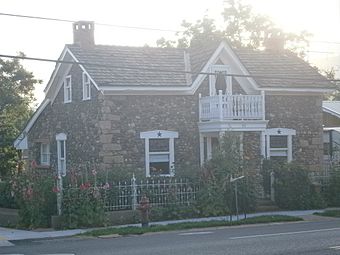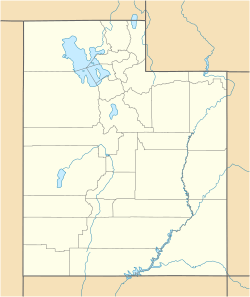Thomas Forsyth House facts for kids
Quick facts for kids |
|
|
Thomas Forsyth House
|
|
 |
|
| Location | 111 N. Toquerville Blvd., Toquerville, Utah |
|---|---|
| Area | less than one acre |
| Built | c. 1868 |
| Built by | Thomas Forsyth |
| NRHP reference No. | 82004184 |
| Added to NRHP | February 11, 1982 |
The Thomas Forsyth House is a very old and important home in Toquerville, Utah. It was built around 1868 by Thomas Forsyth, who was one of the first settlers, also known as Mormon pioneers, in the area. He lived there until he passed away in 1898.
Thomas Forsyth was busy running mills and drying fruit. He even made his own wine, which he kept in the cellar. His wife, Mary Browett Holmes, had her own business, running a glove shop. The house is a simple, one-and-a-half-story building made of fieldstone. It shows what homes looked like during the pioneer times.
This house was added to the National Register of Historic Places on February 11, 1982. This means it's recognized as a special place because of its history and how it was built. It's important for understanding the early settlement of "Utah's Dixie," which is what people called southern Utah back then.
What the House Looks Like
The Thomas Forsyth House is one and a half stories tall and has a basement made of rock. This basement used to be a wine cellar. The walls are built from rough, uneven stones, with neatly cut stones at each corner.
Inside, each floor has four rooms. The front of the house looks simple and balanced. There's even a door in the attic's pointed roof (called a gable) that allowed large items to be moved upstairs. Two big stone fireplaces are still in the front rooms. At the back, there's a one-story addition, called a lean-to, which was the kitchen and had the stairs to the upper floor.
Over the years, some parts of the house have changed. The original windows were replaced, and a third fireplace in the kitchen was removed. Around 1915, a porch and balcony that ran along the front of the house were taken down. A new window was added to the south wall of the kitchen area, and a modern bathroom was built at the back. Even with these changes, the house still looks much like it did when it was first built.
The Story of Thomas Forsyth
Thomas Forsyth was born in Kelso, Scotland, on September 20, 1813. He moved to Port Huron, Michigan, in April 1839. He and his first wife, Isabella Donald, became members of the LDS Church in 1844. They then moved to Nauvoo, Illinois, which was a main gathering place for Mormons at the time.
In 1850, Thomas and Isabella traveled west to Salt Lake City. Sadly, Isabella passed away there two years later. Thomas married Mary Ann Browett in 1854.
By 1865, Thomas and Mary had moved to Washington County in southern Utah. Thomas first ran a shingle mill and a sawmill in a place now called Forsyth Canyon. He provided shingles for the Washington Cotton Factory. But when he found out many other mills were opening nearby, he decided to move to Toquerville.
On the Ash Creek, he built a new mill. It cost a lot of money, about $4,000, but it was very successful in some years.
Thomas built his house using fieldstone and lumber from the Pine Valley Mountains, which he processed at his own sawmill. Some people also say a person named G.M. Spilsbury helped build it. Thomas kept his cellar full of wine he made himself. This wine was even used in Church ceremonies. He also built the first machine in southern Utah for drying fruit.
His wife, Mary, was also very busy. She traded dried peaches with Native Americans for buckskins (deer hides). Mary then tanned the leather and ran a glove shop, though that building is no longer standing. There's a story that when the Church decided people should no longer drink wine, Mary went home and cut the pipes in the cellar, draining all the wine away.
When Thomas Forsyth died in 1898, he left the house to his youngest son, Benjamin Henry Forsyth, and Benjamin's wife, Barbara Ann Lamb. They had been living in a smaller building behind the main house. After Benjamin died in 1948, the house was sold and has been owned by private families ever since. It is one of the few pioneer homes left in Washington County.
The Thomas Forsyth House was officially added to the National Register of Historic Places on February 11, 1982. This was because of its important history and how it represents the very first settlements in "Utah's Dixie."


